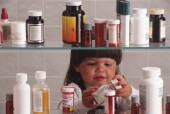
FRIDAY, Sept. 16 (HealthDay News) — Despite ongoing prevention efforts, a growing number of young children are being accidentally poisoned with medications, according to new research.
The study, which was based on data reported to the American Association of Poison Control Centers between 2001 and 2008, found that medication poisoning among children aged 5 and under increased by 22 percent, although the number of children in the United States in this age group rose by only 8 percent during the study period.
“The problem of pediatric poisoning in the U.S. is getting worse, not better,” Dr. Randall Bond, of Cincinnati Children’s Hospital Medical Center, said in a hospital news release.
In conducting the study, which is scheduled for publication in the Journal of Pediatrics, the researchers reviewed information on over 544,000 children who landed in the emergency department due to medication poisoning over the course of the seven-year study period.
The vast majority (95 percent) of emergency department visits were the result of self-ingestion (the kids took the medicine themselves by accident), the investigators found. Prescription drugs were involved in 55 percent of the emergency visits, 76 percent of the hospitalizations and 71 percent of significant injuries.
Opioid-containing pain medications (such as morphine, codeine and oxycodone), as well as muscle relaxants, sleeping pills and heart medications had the biggest impact, the study authors noted in the news release.
The researchers suggested that the reason for the trend is likely due to greater availability and easier access to medications in children’s homes. They also noted that “poison-proofing” efforts, such as safe guards on packaging and child-proofing in the home, may have declined in recent years.
“Prevention efforts of parents and caregivers to store medicines in locked cabinets or up and away from children continue to be crucial. However, the largest potential benefit would come from packaging design changes that reduce the quantity a child could quickly and easily access in a self-ingestion episode, like flow restrictors on liquids and one-at-a-time tablet dispensing containers,” said Bond.
He added that these types of changes should apply to both pediatric and adult prescription and over-the-counter medications.
More information
The U.S. Centers for Disease Control and Prevention has advice on how to protect children from accidental poisoning.

